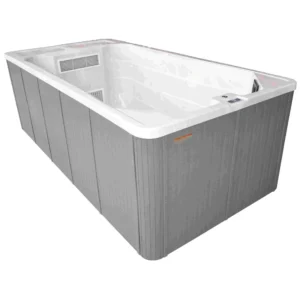
You might be wondering if your swim spa is just a warm-weather thing. I used to think the same. But here’s the truth—yes, you can use a swim spa in the winter.
Actually, it can be one of the coziest ways to enjoy the cold months.
Let’s break this down in a way that’s simple, real, and doesn’t feel like you’re reading a brochure.
Why You’d Want to Use a Swim Spa in Winter
There’s something weirdly satisfying about sitting in hot, bubbling water while the snow falls around you.
I’m not just saying that—it’s backed by science.
Warm water therapy, especially in cold weather, helps relax your muscles and ease joint pain. The heat improves blood circulation, which is often sluggish when you’re freezing.
Using a swim spa is also a way to stay active. Swimming is a low-impact workout that’s easy on your joints. You can stretch, paddle, or even jog in place thanks to the strong water jets.
Some people even say it helps with seasonal blues. I can relate. Getting outdoors—even if it’s just to your backyard spa—can boost your mood.
Still unsure? Check out this swimming spa Chinese-SS398-S to see one in action.
But Won’t It Freeze?
It’s a fair question.
Swim spas are designed to handle cold climates. As long as your unit is properly insulated and you keep the cover on when not in use, it’s safe.
Modern swim spas often include:
Freeze protection settings
Insulated cabinets
Energy-efficient heating systems
Some models even include smart thermostats that kick in if the temperature drops too low.
If you’re considering an upgrade, look at the swimming spa manufacturers-SS790. These are built with winter in mind.
Keeping It Running Smoothly in Cold Weather
You’ll want to do a few things differently when using your swim spa in the winter.
Here’s a basic checklist I follow:
Use a thermal cover. It traps heat and prevents freezing.
Keep water levels consistent. Too low and your heater may shut off.
Check water chemistry regularly. Cold temps can throw off balance faster.
Run your spa daily. Even a short cycle keeps water from freezing.
Inspect your pipes. Look for leaks and cracks before winter hits.
If you’re not sure what kind of cover or parts to use, this swimming spa factories-SS585 line has solid accessories worth checking out.
Pros of Using a Swim Spa in Winter
Let’s be real. It’s not just about warmth.
There are several solid benefits:
Active Lifestyle: You don’t have to pause your workouts when it snows.
Better Sleep: Warm water soothes your nervous system.
Family Time: It’s a fun way to bond (even if someone screams getting out).
Stress Relief: End your day with a soak. You’ll feel it melt away.
Bonus: It makes winter feel less long.
Are There Any Risks?
Sure. Like with anything, there are a few precautions.
Hypothermia is rare, but it can happen if you stay in too long and your spa isn’t actually warm enough. I always double-check the temp before getting in.
Slipping is another one—wet feet and icy decks don’t mix.
Try these quick fixes:
Lay down rubber mats near the entrance.
Use handrails (I didn’t think I needed these… I was wrong).
Keep towels and a robe close by.
Also, talk to your doctor if you have heart issues or medical conditions before diving in during freezing temps.
What About Energy Use?
Yes, your energy bill may go up. But not by much if your swim spa is insulated and well-maintained.
Tips to keep it affordable:
Set the temp lower when not in use
Use a swimming spa supplier-SS580 model with energy-efficient heating
Keep the cover on tight
Avoid leaving it running 24/7 if you’re not using it daily
Some people install windbreaks like fences or shrubs to cut down heat loss. It helps, and it looks pretty too.
What Temperature Should the Water Be?
For winter use, a good range is 95°F to 104°F (35°C to 40°C).
Any hotter, and you risk overheating. Any colder, and it defeats the point of warming up.
I usually keep mine around 100°F.
A digital thermostat helps you dial in the exact temp and prevents guesswork.
Is Winter Swim Training a Thing?
Surprisingly, yes.
Athletes use swim spas year-round for resistance training and muscle recovery.
The jets let you simulate swimming against a current, which is great if you’re like me and don’t want to swim laps in a huge pool.
Winter swim training helps:
Boost endurance
Improve circulation
Build core strength
Stay conditioned for summer sports
Check out the swimming spa exporter-SS398-B if you’re looking into a swim spa with solid resistance training options.
Closing Thoughts: Is It Worth It?
If you already have a swim spa, winter shouldn’t stop you.
If you don’t yet, it might be time to consider it.
Sure, it takes a bit of effort—especially in freezing climates—but once you’re soaking in warm, bubbling water while the snow falls, you’ll realize it’s totally worth it.
It’s like having your own personal retreat right in your backyard.
And hey, who doesn’t want to beat the winter blues in style?
Final Tips
Keep your spa clean and covered
Don’t use it alone if it’s icy out
Stay hydrated—even if it’s cold
Add some lights or plants to make it feel cozy
Want to explore different swim spa options? Check out the swimming spa manufacturer-SS630 or swimming spa China-SS745. These models are great for year-round use.
Need More Info?
Still unsure about cold-weather swim spas? Read more detailed guides on swimming spa distributors or consult Veritas Wellness.
